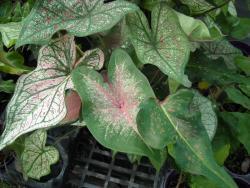By "well-lit" I mean about as bright as winter sun. Winter sun is more like summer part shade, so that is ideal for Caladiums.
You know they are going dormant when they stop producing new leaves and the old leaves start to die off. Around here, I can end up with one or two leaves hanging on into December, but you don't have to keep them up that long (unless you want to try). Once you see that they are "declining", then you can let them dry out. In their native habitat, they go through wet and dry seasons. The onset of the dry season is when they go dormant, but if the wet season lasts longer, they'll tend to stay up longer. I suggest that you grow them so that you have them up for at least 6 months, longer if possible. With proper care, you can get a LOT of growth in those months. Mine go from one or two leaves from a good sized tuber to a pot jammed full in 2 1/2 months, but then again this is deep tropics compared to where you are.
For storage, I would keep them in their pots but I would do it as follows: when they are fully dormant, unpot them and inspect the tubers. They should be firm and not mushy, and the soil by this time should be dried out. Loosen up the soil, remove any detritus like dead leaves, etc. and then repot them in the fluffed up dry soil. Do not water! This way, come Spring, it will be easy for you to poke around to look for sprouts, the signal that they are ready to come up.
Make sure when you store them that it is not a location where the temps can get near freezing. If they get that cold, they could rot away, or be very slow to start up in the Spring. With your short season, you don't need any additional delays to growth!

